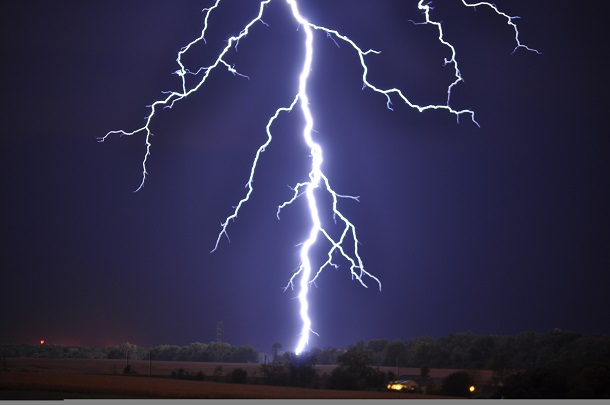I was talking to someone recently and they told me that they really didn’t understand grounding. There are a lot of resources on this blog having to do with grounding. But, when I look at them, I realize that there’s no single article that goes over the grounding in a really basic way. So, I decided to write one.
Note: Experienced RF engineers will probably be tempted to point out minor inaccuracies in this article. I admit that I’m simplifying a lot of this so that it is as easy to understand as possible. If you’re really interested in the science of grounding, I encourage you to seek out college courses on the subject.
Basically, here’s what grounding is and why you need it
Stray electricity is everywhere. All life runs on electricity, and electricity is generated practically any time that two things come into contact. Electricity is even flowing through the air. In fact, all broadcasting is really just electricity flowing through the air.
Normally, the amount of electricity in the air is pretty small. It’s there all the time and it’s not dangerous to you. However, there are cases where enough stray electricity is in the air that it becomes dangerous. When clouds interact with each other, they generate an electrical charge. That electrical charge has a natural tendency to flow toward the center of the earth. The problem is, that it will flow through anything that comes between it and the center of the earth. The stuff that comes between it, whether it’s a house, a person, or a TV, will usually be destroyed.
The idea of grounding is that you provide a way for that stray electricity to travel down to the ground without going through things like houses and people. Grounding dissipates electricity harmlessly. This keeps your valuable things (and you) from being destroyed. It also means the stray electricity doesn’t interact with the electricity in your wires, and that’s important to make sure your video and audio equipment works right.
How is grounding done?
The idea of grounding is simple. You create a path between a piece of metal and the ground. This is done using a copper wire. Copper carries electricity much more easily than human beings or wood, and electricity is “lazy.” Electricity, like water, will always flow in the easiest possible path. So if we give the electricity a nice easy copper wire, with a straight line to the ground, the electricity won’t bother to go through your house or your body.
Things that are made of metal usually have green screws that are used to connect dedicated ground wires. The wire runs from that metal thing (like a TV antenna) to something connected straight into the dirt. This can be a dedicated grounding rod, a cold-water pipe, or something else that’s connected to the ground. Every city and county has its own ordinances around what things you can use for grounding.
In order to keep stray electricity from affecting sensitive equipment, electrical devices also have one of the “pins” of the plug dedicated to grounding. When devices inside the house connect to the grounding system of the building, that’s generally called bonding.
What needs to be grounded?
Everything made of metal that’s outside should be grounded. It doesn’t matter if it’s not very high up, it should be grounded. It’s most important to ground the thing that’s highest up because that’s where electricity will flow first. But every metal item needs to be grounded or bonded. There’s no such thing as too much grounding, so don’t be afraid to ground things if you’re not sure it’s needed.
Warning: grounding will NOT protect your house from a lightning strike
This is the biggest misconception about grounding. A lightning strike is about 300,000,000 volts and 30,000 amps. If it strikes something on your house, no skinny little copper wire is going to handle it. There are large devices called lightning arresters which are designed to protect large installations from lightning strikes. However, they block all electricity meaning they don’t work with antennas or satellite dishes.
What grounding does do is to dissipate stray electricity around your house so that a lightning strike is less likely to happen. Grounding keeps that stray electricity from building up so it never turns into a lightning strike.
Who should I go to to help with grounding?
A local electrician or contractor should be able to help you with grounding. The laws around grounding vary because some areas are drier or wetter or have different terrains. If you don’t know the laws in your area, your local city clerk can help you.
However, I’ve said it before and I’ll say it again — some grounding is better than no grounding. If you’re not sure what’s legal in your area and you aren’t going to be able to find out for a while, do what you can. Ground everything the best way you can and then go back and fix what needs to be fixed when you can.
The simplest form of grounding means getting hold of some ground wire. Don’t use any other copper wire if possible. Connect one end of the wire to something metal that’s outside, preferably using the green screw you’ll find on it. Run the other end to something metal in the ground. This can be a ground rod, an exposed metal pipe, or even a metal fencepost if that’s all you have. Really that’s all it takes.
Remember, these are just suggestions. What’s legal and required varies from city to city.
What if I don’t ground anything?
I’m not going to paint you this grim picture of your house going up in a ball of flames because you didn’t ground your TV antenna. It’s possible yes, but it probably won’t happen. Still, one lightning strike can destroy your home and everything in it (including you.) Even though lightning strikes are rare, they do happen and you should take precautions against them. A few dollars spent on some copper wire, and a little bit of time spent on a weekend, are a small price to pay.
If you’re looking for grounding supplies, shop at Solid Signal. If you’re looking for the kind of equipment that needs to be grounded, call the experts at 888-233-7563. We’ll help you figure out what you need and work with you from beginning to end. Call us during East Coast business hours or fill out the form below.




